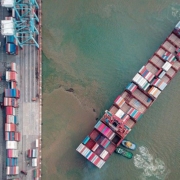Maritime ports serve as a natural test bed for blockchain ecosystems
Testing smart city concepts, technologies and operations in a semi-confined setting
As detailed in TBR’s most recent Digital Transformation: Blockchain Market Landscape, maritime ports present an intriguing test bed for blockchain technology, given three intertwined elements essential to successful blockchain adoption. First, ports rest at the center of a diverse ecosystem, with players engaging directly on varying cadences, with different technologies and IT infrastructures and collaborative as well as competing needs — in short, a place messy and competitive enough to warrant a comprehensive solution to restrain complexity and digitize trust. (And if you do not believe ports can be messy, corrupt places, watch the second season of HBO’s “The Wire.”) Second, governments typically have a strong interest in port operations, either running them as quasi-governmental entities or regulating and overseeing them to advance national security and local and/or regional economic interests. For blockchain, as has been made clear in this report, government involvement can accelerate adoption. And third, with their diverse landscape of actors — shipping companies, trucking companies, freight forwarders, inspectors, stevedores, even local fire and rescue units — maritime ports are self-contained mini-universes, like small cities, a characteristic that pulls together the diverse ecosystem and government interest into a useful whole, for the purposes of blockchain.
As TBR noted previously, “The Port of Oulu has taken an approach shared by most municipalities looking to become a smart city — start small, but with a large, long, deep vision, and build incrementally … a port like Oulu’s, which is both small enough to be manageable through a disruptive digital transformation and large enough to be replicative of a larger port’s ecosystem and challenges, could be an ideal place for connectivity and emerging technology vendors to experiment and prove out the use case for bringing one of the most fundamental infrastructure environments fully into the digital age.”
Some blockchain consultancies have been experimenting with these ideas, as we noted here: “For EY, a firmwide approach to addressing every element of trade — including supply chain, tax and regulatory compliance, blockchain solutions, in-port IoT, connectivity to inland regions, and real-time shipping data — comes together under its NextWave Global Trade Initiative, a white space for EY to build cross-border, cross-service-line and cross-industry solutions.”
As is clear from both the Oulu and EY examples, blockchain can only be part of a port’s digital transformation, not the entirety of it. In line with the concept that a “rising tide lifts all ships,” connectivity, IoT and analytics round out the picture (cloud and cybersecurity should already be there), making blockchain an essential component, if not the most easily adopted or most transformational (arguably IoT sensors on every element of a port — with supporting analytics and insights — would more rapidly lead to streamlined operations, even if blockchain-enabled tracking and trade-based financing would lead to longer-term value).
Even recognizing the limitations, for blockchain services vendors, maritime ports may provide an essential opportunity to test solutions in diverse, yet manageable, ecosystems while partnering with governments or quasi-governmental institutions that will be critical to wider blockchain adoption. If the use case appears limited, consider the more than 50 ports that exist between Duluth, Minn., and the Atlantic Ocean. Blockchain-enabling that supply chain archipelago could be a massive use case and spark wider adoption across the enterprises interacting with every one of those ports.
For further details about blockchain in the context of digital transformation, IT services and consulting, see TBR’s most recent Digital Transformation: Blockchain Market Landscape, which includes use cases, vendor insights, and client pain points and needs.




Leave a Reply
Want to join the discussion?Feel free to contribute!